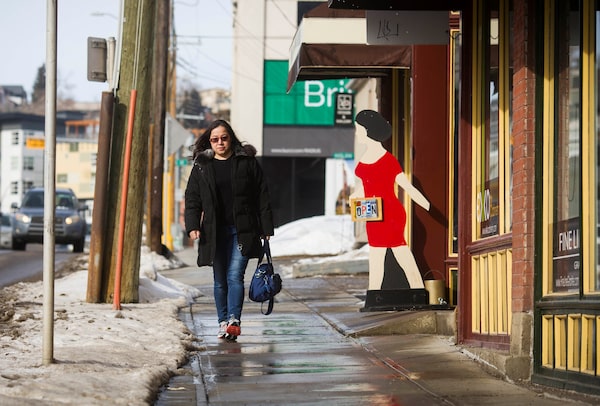
Amy Leung walks to a local grocery store near her neighbourhood in Calgary on March 16, 2018.Todd Korol/The Globe and Mail
Granite counters, a fifth bedroom or a three-stall garage were not the features that swayed the buyer toward Edmonton realtor Sara Kalke’s most expensive listing in 2017. Instead, it was the property’s walkability.
Ms. Kalke says she’s tied into a growing trend in Canada’s most car-crazy province – house hunters looking for homes where the need to drive is minimal and the distance to the amenities of urban life is measured in footsteps, not kilometres.
Ms. Kalke is so convinced that the walkability trend is growing that she has geared a significant chunk of her business toward attracting a car-averse clientele. Her results so far have been promising.
Ms. Kalke landed her most valuable sale last year, at more than $1-million, in the inner-core Edmonton neighbourhood of Parkview, through the reputation she’s built with Walkable Edmonton, a website she launched last February. The site combines a hyper-local blog, social-media feeds and videos about shops and neighbourhoods with traditional real-estate listings.
Statistics Canada data show that residents of Alberta’s two largest cities are the most likely in Canada to use a car to make every one of their daily trips. And with Edmonton’s population growing at 13.9 per cent and Calgary’s at 14.6 per cent, according to the 2016 census, the province’s roads seem destined to get even more crowded.
A study by the Realtors Association of Edmonton confirms the tight grip suburbia has on local homebuyers. In 2017, sales in just one suburban slice of Edmonton – the southwest, where walking is not realistic for anything but recreation – accounted for nearly 20 per cent of the city’s $965-million in residential housing sales. Meanwhile, the entire walkable inner city accounted for just 16.6 per cent.
But Ms. Kalke and several other agents in Alberta nonetheless see walkability as the future. They say their customers are car-averse millennials, downsizing boomers and new residents moving to Alberta from other urban centres, where walkability has already firmly taken root. All of them, they say, want to live differently, with less reliance on automobile ownership.
They also say Alberta developers are taking notice, though municipal policies seem to be lagging behind.
The idea for Walkable Edmonton, Ms. Kalke says, came from the buyers themselves. She says they would use the word “walkable” to describe to her the kind of place they wanted to live in; somewhere with a street life, a sense of community and proximity to amenities. “With just one word I was able to narrow things down from all properties to not only an area [of the city] but also a lifestyle I knew people were after,” she says.
Twelve of her 105 total sales in 2017 were linked to the Walkable Edmonton site.
Still, she says, walkablility isn’t at the top of every homebuyer’s list, and her business model has to reflect that. “You have to be brave enough to realize when you’re targeting a very small market, because you’re intentionally not targeting the rest.”
Calgary buyers are also increasingly demanding walkability.
More than 20 years ago, Christina Hagerty coined “Wanna Buy a Loft?” as her sales motto and focused on property listings no more than 10-minutes from the downtown core. She says she was also likely one of the first in the province to include a Walk Score with listings.
Today, Ms. Hagerty doesn’t focus explicitly on walkability but says she captures it within the lifestyle she targets. “I call it this ‘village lifestyle’ because everything you need in a village is there, from the bakery to the wine store, to the restaurant to the grocery store.”
Like Ms. Kalke, buyers moving to Alberta from urban centres elsewhere seek out Ms. Hagerty because of her reputation with walkability, because they want to move to Alberta, but remain car free.

Ms. Leung says proximity to the C-Train means she can get by without a car.Todd Korol/The Globe and Mail
Amy Leung, a retired, 53-year-old recent immigrant to Calgary from Hong Kong, insisted on walkability for her condo purchase through Ms. Hagerty.
“Coming [to Calgary] from a major city, I never drove and have never obtained my driver’s license,” she says. “Transit was very convenient in Hong Kong. Being walking distance to grocers and activities allows me to continue my car-less lifestyle. And with the C-train beside me, I don’t require a car and don’t need to burden anyone to get around.”
Parking-stall prices are also pushing a shift toward walkability, Ms. Hagerty says. She estimates the average price for a stall in a newer condo building within the Calgary core has risen to between $25,000 to $35,000. And any stall posted in this range “would sell immediately,” noting that there are groups of buyers not wanting the stall to begin with and others who are wed to car-dependency who are hungry to buy unused parking.
Developers are responding, if cautiously, to buyers who don’t subscribe to car-dom. N3, a 167-unit that Knightsbridge and Metropia developed in Calgary that’s now sold out, offered condos starting in 2016 without parking stalls. That has shifted the conversation about what was possible, Ms. Hagerty says. In the interim, several other developments, such as Orange Lofts in the East Village, now offer a portion of total units without parking stalls. But Ms. Hagerty says these types of projects are “few and far between.”
“I think it’s the city [that] needs to turn around, not so much that the public isn’t ready for it. The city still has a bunch of rules and regulations that you have to have X amount of parking stalls if you’re about to build a project.”
That holds true in Edmonton, where downtown condos are still well supplied with parking. The Ultima, for example – a 32-storey glass high-rise, just steps from the new Rogers Place arena, recently sold an extra stall to a buyer, who wanted two, for $75,000. The building has 199 units and 300 parking stalls. It is also using a 2014 Bentley Continental as a deal sweetener to sell its largest unit, priced at $3.13-million.
Darcy Torhjelm, chair of the Realtors Association of Edmonton, says that walkability is not at the top of most Alberta homebuyer’s must-have lists at the moment. What is, he says, is affordability and a place that’s set up to raise a family. Still, Mr. Torhjelm says what’s a tiny market now for walkable homes could well expand.
“I think it’s going to be a little more predominant down the road. These realtors may have just hit a niche that’s a marketable area.”
Ms. Kalke would likely agree. Last year her site caught the eye of friends of a wealthy Toronto couple – a professor and a surgeon – who were relocating. The couple were looking for a house in Edmonton like their current place in Toronto, that didn’t require a car to connect them to food, friends and fun. The couple’s Edmonton friends recommended Ms. Kalke.
“So, here come these complete strangers from Toronto to buy this beautiful, million-dollar house, just from Walkable Edmonton,” Ms. Kalke says. “There’s been this really big cultural shift and I’m like a surfer on the wave.”